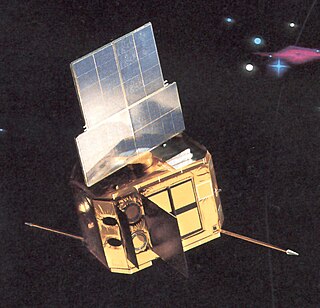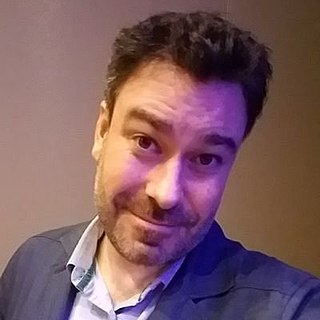
A blazar is an active galactic nucleus (AGN) with a relativistic jet directed very nearly towards an observer. Relativistic beaming of electromagnetic radiation from the jet makes blazars appear much brighter than they would be if the jet were pointed in a direction away from Earth. Blazars are powerful sources of emission across the electromagnetic spectrum and are observed to be sources of high-energy gamma ray photons. Blazars are highly variable sources, often undergoing rapid and dramatic fluctuations in brightness on short timescales. Some blazar jets appear to exhibit superluminal motion, another consequence of material in the jet traveling toward the observer at nearly the speed of light.
Andreja Gomboc, is a Slovenian astrophysicist.

The European X-ray Observatory Satellite (EXOSAT), originally named HELOS, was an X-ray telescope operational from May 1983 until April 1986 and in that time made 1780 observations in the X-ray band of most classes of astronomical object including active galactic nuclei, stellar coronae, cataclysmic variables, white dwarfs, X-ray binaries, clusters of galaxies, and supernova remnants.

The Brera Observatory is an astronomical observatory in the Brera district of Milan, Italy. It was built in the historic Palazzo Brera in 1764 by the Jesuit astronomer Roger Boscovich. Following the suppression of the Jesuits by Clement XIV on 21 July 1773, the palace and the observatory passed to the then rulers of northern Italy, the Austrian Habsburg dynasty.

Paolo Padovani is an Italian astronomer working at the European Southern Observatory, specializing in the study of Active galactic nuclei including the study of quasars and blazars, evolution and multifrequency studies and extragalactic backgrounds. In 2004 he and several other astronomers discovered 30 supermassive blackholes at the European Astrophysical Virtual Observatory using pioneering techniques.

Gamma-ray astronomy is the astronomical observation of gamma rays, the most energetic form of electromagnetic radiation, with photon energies above 100 keV. Radiation below 100 keV is classified as X-rays and is the subject of X-ray astronomy.

Markarian 501 is a galaxy with a spectrum extending to the highest energy gamma rays. It is a blazar or BL Lac object, which is an active galactic nucleus with a jet that is shooting towards the Earth. The object has a redshift of z = 0.034.

Franco Pacini was an Italian astrophysicist and professor at the University of Florence. He carried out research, mostly in High Energy Astrophysics, in Italy, France, United States and at the European Southern Observatory.

Time-domain astronomy is the study of how astronomical objects change with time. Though the study may be said to begin with Galileo's Letters on Sunspots, the term now refers especially to variable objects beyond the Solar System. Changes over time may be due to movements or changes in the object itself. Common targets included are supernovae, pulsating stars, novas, flare stars, blazars and active galactic nuclei. Visible light time domain studies include OGLE, HAT-South, PanSTARRS, SkyMapper, ASAS, WASP, CRTS, and in a near future the LSST at the Vera C. Rubin Observatory.
The Astronomer's Telegram (ATel) is an internet-based short-notice publication service for quickly disseminating information on new astronomical observations. Examples include gamma-ray bursts, gravitational microlensing, supernovae, novae, or X-ray transients, but there are no restrictions on content matter. Telegrams are available instantly on the service's website, and distributed to subscribers via email digest within 24 hours.
Robert J. Nemiroff is an Astrophysicist and Professor of Physics at Michigan Technological University. He received his Ph.D. from the University of Pennsylvania in Astronomy and Astrophysics in 1987 and his B.S. from Lehigh University in Engineering Physics in 1982. He is an active researcher with interests that include gamma-ray bursts, gravitational lensing, and cosmology, and is the cofounder and coeditor of Astronomy Picture of the Day (APOD), the home page of which receives over a million hits a day, approximately 20% of nasa.gov traffic. He is married and has one daughter.
Multi-messenger astronomy is astronomy based on the coordinated observation and interpretation of signals carried by disparate "messengers": electromagnetic radiation, gravitational waves, neutrinos, and cosmic rays. They are created by different astrophysical processes, and thus reveal different information about their sources.

Jacob Noel-Storr is an astrophysics researcher and science education and outreach specialist researcher, Presently the lecturer for practical astronomy and X-Lab-PAM team leader at the University of Groningen and president of InsightSTEM, Inc. He was an assistant research professor and director of the Insight Lab for Science Outreach and Learning Research at Rochester Institute of Technology, and assistant staff scientist in the Steward Observatory and Flandrau Science Center at the University of Arizona. He is known for contributions to the study of Active Galactic Nuclei / Supermassive Black Holes, as well as science / astronomy education and outreach.

Chryssa Kouveliotou is a Greek astrophysicist. She is a professor at George Washington University and a retired senior technologist in high-energy astrophysics at NASA's Marshall Space Flight Center in Huntsville, Alabama.
TXS 0506+056 is a very high energy blazar – a quasar with a relativistic jet pointing directly towards Earth – of BL Lac-type. With a redshift of 0.3365 ± 0.0010, it is about 1.75 gigaparsecs from Earth. Its approximate location on the sky is off the left shoulder of the constellation Orion. Discovered as a radio source in 1983, the blazar has since been observed across the entire electromagnetic spectrum.

María Luisa Aguilar Hurtado, was the first professional astronomer of Peru. She studied at the Institute of Mathematics and Physics of the National University of San Marcos in Lima, Peru. She graduated as an astronomer from the National University of La Plata, Argentina. In 1981, motivated to develop astronomy at a professional level, she founded and served as director of the "Astronomy and Astrophysics Seminar", nowadays called "Permanent Astronomy and Space Sciences Seminar" of the National University of San Marcos.

Alessandro De Angelis is an Italian and Argentine physicist and astrophysicist. A Professor of Experimental Physics at the University of Padova and Professor Catedratico of Astroparticle Physics at IST Lisboa, he is mostly known for his role in the proposal, construction and data analysis of new telescopes for gamma-ray astrophysics. He is a member of Istituto nazionale di fisica nucleare (INFN), Istituto nazionale di astrofisica (INAF), Italian Physical Society (SIF), International Astronomical Union (IAU), Gruppo2003.

AP Librae is a BL Lacertae object located at a distance of 700 million light years in the southern constellation of Libra. In the visual band it is one of the most active blazars known. AP Lib is surrounded by an extended source with a spectrum characteristic of a red-shifted giant elliptical galaxy. The derived visual magnitude of this region is 15.0, and it follows a radially decreasing brightness that is characteristic of an elliptical. Seven fainter galaxies are visible within an angular radius of 9′, suggesting it is the brightest member of a galactic cluster.
Giuseppe Cesare Perola was an Italian astrophysicist who has made significant contributions to the study of extragalactic radio astronomy, radiogalaxies, active galactic nuclei, and the growth of supermassive black holes. He began his scientific career at the University of Milan in 1965, working in the group led by Giuseppe Occhialini and Connie Dilworth.












